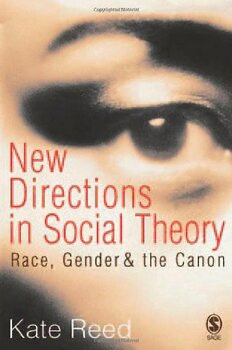
New Directions in Social Theory: Race, Gender and the Canon PDF
Preview New Directions in Social Theory: Race, Gender and the Canon
NDST_FM.qxd 1/9/06 22:22 Page i New Directions in Social Theory NDST_FM.qxd 1/9/06 22:22 Page ii NDST_FM.qxd 1/9/06 22:22 Page iii New Directions in Social Theor y Race, Gender and the Canon Kate Reed NDST_FM.qxd 1/9/06 22:22 Page iv © Kate Reed 2006 First published 2006 Apart from any fair dealing for the purposes of research or private study, or criticism or review, as permitted under the Copyright, Designs and Patents Act, 1988, this publication may be reproduced, stored or transmitted in any form, or by any means, only with the prior permission in writing of the publishers, or in the case of reprographic reproduction, in accordance with the terms of licences issued by the Copyright Licensing Agency. Enquiries concerning reproduction outside those terms should be sent to the publishers. SAGE Publications Ltd 1 Oliver’s Yard 55 City Road London EC1Y 1SP SAGE Publications Inc. 2455 Teller Road Thousand Oaks, California 91320 SAGE Publications India Pvt Ltd B-42, Panchsheel Enclave Post Box 4109 New Delhi 110 017 British Library Cataloguing in Publication data A catalogue record for this book is available from the British Library ISBN-10 0 7619 4270 X ISBN-13 978 0 7619 4270 2 Library of Congress Control Number: 2005928701 Typeset by Newgen Imaging Systems Pvt Ltd, Chennai Printed in India at Gopsons Papers Ltd, Noida Printed on paper from sustainable resources NDST_FM.qxd 1/9/06 22:22 Page v This book is not intended to be a political or historical chronicle, only a series of recollections, which always are selective and tinted by one’s own experience and ideology. Isabel Allende, My Invented Country: A Memoir Social theory is what we do when we find ourselves able to put into words what nobody seems to want to talk about. When we find those words, and say them, we begin to survive. For some, learning to survive leads to uncommon and exhilarating pleasures. For others, perhaps the greater numbers of us, it leads at least to the common pleasure a pleasure rubbed raw with what is: the simple but necessary power of knowing that one knows what is there because one can say it. This, whatever else, is what makes social theory worth reading. Charles Lemert, Social Theory NDST_FM.qxd 1/9/06 22:22 Page vi For Mary Evans NDST_FM.qxd 10/1/06 8:13 PM Page vii Contents Biographical Note x Acknowledgements xi 1. Introduction 1 Sociological Theory Past and Present 4 Changing Concepts: Class, Gender and Race 6 Reasons behind Changes in Sociological Theory 8 Social Change 8 Paradigm Shifts 9 Selection and Exclusion 9 This Book: Themes, Aims and Arguments 10 Chapter Outline 12 Notes 14 Part One: Classical Sociology 2. The Classical Tradition 19 The Emergence of Sociology 20 Race, Gender and the Classical Agenda 21 Karl Marx and the Theory of Capitalism 23 Emile Durkheim and the Study of Social Facts 27 Max Weber and the Science of Interpretation 29 Evaluating the Holy Trinity 32 Peripheral Visions 32 Georg Simmel and the Fragmentation of Society 32 The Endurance of the Classics 35 The Emergence of Sociological Exclusion 37 Conclusion 39 Chapter Summary 39 Further Reading 40 Notes 40 3. Race, Gender and Hidden Classics 42 Race, Gender and Sociological Exclusion 43 Harriet Martineau (1802–1876) 43 W.E.B. DuBois (1868–1963) 47 Anna Julia Cooper (1858–1964) 51 NDST_FM.qxd 10/1/06 8:13 PM Page viii viii Contents The Hidden Classics and Sociological Theory 54 Why Were They Outsiders? 54 From Hidden Classics to Contemporary Insiders 56 Evaluating the Position of the Hidden Classics 57 Changes in Sociology: The Interwar Years 58 The Chicago School: A Move to Inclusion? 58 Robert Park and the Sociology of Race 60 Jane Addams and the Chicago Women’s School 62 Conclusion 64 Chapter Summary 65 Further Reading 65 Part Two:Modern Sociology 4. Theories of the Golden Age 69 The Emergence of Modern Sociology 70 Theories of the Golden Age 71 Talcott Parsons (1902–1979) 72 Crisis and Hope in the Sociological Canon 76 C. Wright Mills (1916–1962) 77 Alvin Gouldner (1920–1980) 80 Gloom and Despair: The Frankfurt School 86 Evaluating Modern Theorists 90 Conclusion 92 Chapter Summary 92 Further Reading 93 5. Race, Gender and Sociological Outsiders 94 Race, Gender and Sociological Exclusion 95 Hannah Arendt (1906–1975) 95 Frantz Fanon (1925–1961) 100 Simone de Beauvoir (1908–1986) 104 Outsider Visions and Sociological Theory 108 Why Were They Outsiders? 109 From Modern Outsiders to Contemporary Insiders 110 Evaluating Modern Outsiders 111 The Challenge to Western Sociology 112 The Feminist Challenge to Social Theory 113 The Growth of the Sociology of Race 115 Conclusion 116 Chapter Summary 117 Further Reading 117 NDST_FM.qxd 10/1/06 8:13 PM Page ix Contents ix Part Three: Contemporary Sociology 6. Postmodernism and Social Theory 121 Changes in Sociological Theory 122 Postmodernism and Sociological Theory 123 Postmodernism, Class, Race and Gender 125 Contemporary Social Theorists 127 Anthony Giddens (1938–) 128 Donna Haraway (1944–) 132 Stuart Hall (1932–) 136 Is This the End of Sociological Outsiders? 140 Conclusion 142 Chapter Summary 143 Further Reading 143 7. Beyond Sociological Exclusion 144 Rewriting Sociological Theory’s Past 146 Writing Contemporary Social Theory 149 Race, Gender and the Centring of Outsiders 149 Gender, Race and Public Social Theory 152 Empirically Orienting Social Theory 154 Limitations to Gendered and Racial Inclusion 156 The Future of Social Theory 157 Book Overview 159 Conclusion 160 Chapter Summary 161 Further Reading 162 Note 162 References 163 Index 173
